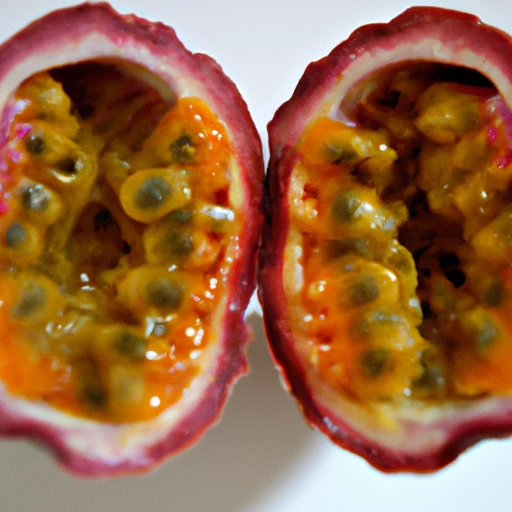Passionfruit
Description

Passionfruit, known for its vibrant tropical flavor, is a round to oval fruit with a tough outer rind and a juicy, seed-filled interior. Its aromatic flesh ranges from yellow to deep orange, encasing numerous small, edible seeds. Passionfruit, or Passiflora edulis, is native to South America but is now widely cultivated in various tropical and subtropical regions around the world, making it a cherished ingredient in many culinary traditions.
Common uses
Passionfruit is commonly used to enhance the flavor of desserts, beverages, and savory dishes. Its tangy and sweet taste complements a variety of ingredients, making it a favored choice for chefs and home cooks alike. It's often scooped out and eaten fresh, used in fruit salads, or added to yogurt and smoothies for a tropical twist. Passionfruit pulp, juice, and seeds are also popular in sauces, dressings, marinades, and as a topping for ice creams and pastries.
Nutritional value
Calories
A 100-gram serving of passionfruit contains approximately 97 kcal (calories).
Protein
This serving size provides about 2.2 g of protein.
Fat
Passionfruit is low in fat, with only 0.7 g per 100 grams.
Carbohydrates
It contains about 23.4 g of carbohydrates, mainly from sugars and dietary fiber.
Vitamins
Passionfruit is rich in vitamins, particularly vitamin C, providing 30 mg per 100 grams, and vitamin A, offering 1274 IU (International Units).
Minerals
It also offers essential minerals like potassium, with 348 mg per 100 grams, and magnesium, with 29 mg per 100 grams.
Health benefits
The high vitamin C content in passionfruit is excellent for boosting the immune system, while the dietary fiber helps improve digestive health. The fruit's rich antioxidant profile contributes to skin health and may reduce oxidative stress. The presence of plant compounds like piceatannol is linked to various health benefits, including anti-inflammatory effects.
Potential risks
While passionfruit is generally safe for most people, those with a latex allergy may experience cross-reactivity due to similar proteins. Additionally, the seeds can pose a choking hazard for small children or those with difficulty swallowing. As with any food, moderation is key to avoid gastrointestinal discomfort from excessive fiber intake.
Common recipes
Passionfruit is featured in a variety of recipes such as passionfruit mousse, pavlova, cheesecakes, and tropical drinks like passionfruit margaritas or smoothies.
Cooking methods
While often eaten fresh, passionfruit can be baked, blended, or boiled as part of dessert recipes or sauces.
Pairing with other ingredients
It pairs well with coconut, mango, banana, and citrus fruits, as well as poultry and seafood, adding a zesty flavor to these dishes.
Summary
Passionfruit stands out as a versatile and nutritious ingredient that captivates the senses with its exotic taste and aroma. It's a vibrant addition to any kitchen, offering both health benefits and a burst of tropical flavor to a diverse range of culinary creations.